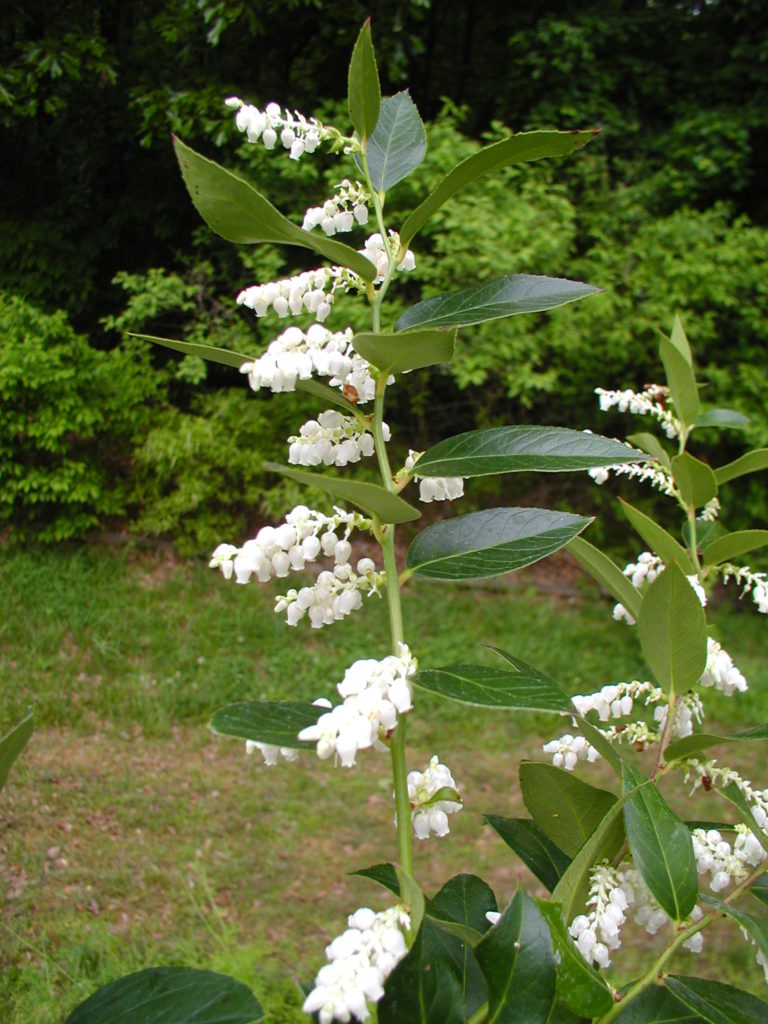Doghobble is a graceful, informal, evergreen shrub common in the Atlantic and Gulf coastal plain which shows off best when planted in mass. Stoloniferous, it is naturally found in drifts or colonies along banks of creeks or shady ditches and woodlines. Doghobble’s arching form reaches 3-4 feet or 4-6 feet (reports vary) by an indeterminate width. Stems are rarely branched, but arching wih a zig-zag pattern, bearing thick, evergreen leaves, and clusters of white, fragrant, urn-shaped flowers in May. If grown in enough light, the leaves turn an ornamental purplish-bronze in winter. Well suited as a foundation plant or hedge, it thrives in shady yards or gardens. Doghobble is a slow grower and its growth form provides an attractive visual contrast to sheared evergreen foundation plants. Traditionally found in the same type of environments as rhododendrons, Doghobble prefers moist, acidic, organic, well drained soil and full to part shade, but will tolerate sun if the soil is kept moist.
NURSERY HOURS
Wednesday: 10-4 Thursday: 10-6 Friday-Saturday: 10-4 Sunday: 12-4
Leucothoe axillaris

Key Info
Scientific Name: Leucothoe axillaris (Lamarck) D. Don
Common Names: Coastal Leucothoe, Doghobble, Coastal Doghobble, Swamp Doghobble, Swamp Dog-Laurel, Fetterbush, Maleberry, Sweetspire
Family Names: Ericaceae (Heath Family)
Plant Type: Tree / Shrub
Moisture Requirement: Moist well drained
Leaf Retention: Evergreen
Flower Color: White
Special Characteristics: Tolerates heat and humidity, Tolerates shade, Reported to be deer resistant., Evergreen, Fragrant flowers
Additional Info
Habit: Multi-stemmed shrub with arching branches and zig-zag pattern at the ends; foliage is of medium texture, bark is smooth, light brown; is stoloniferous.
Height: 3' to 4'
Spread: 4' to 5'
Soil Conditions: Prefers moist, well drained, acidic, organic soil; pH very acidic to slightly alkaline; light (sandy), medium (loamy) and heavy (clay) soils.
Leaves: Leaves are alternate, simple, leathery, abruptly to gradually pointed, lustrous dark green above, pale and lighter beneath, pinnately veined; 2 to 4 inches long by half as wide, with margins unevenly serrated; turn red or bronze in fall and winter.
Flowers (or reproductive structures: Flowers are inverted urn shaped, white to pink-flushed, about 1/4 to 1/3 inch long clustered in axillary racemes 2.5 - 3.0 inches long.
Fruit: The fruits are dry, brown, globular, 5-lobed capsules about 1/4 inch across, more or less depressed at the apex, in long axillary clusters. Mature in fall.
Natural Distribution: Wet woods, shady flood plains and stream banks
USDA Hardiness Zone: 6 to 9
USDA Wetland Indicator Status in NC: FACW
Pollination: Bees, butterflies, other insects
Wildlife Connections: Bees are attrracted to the flowers, deer eat the leaves; the Doghobble thickets provide cover for many small creatures.
Propagation: By seeds and cuttings.
